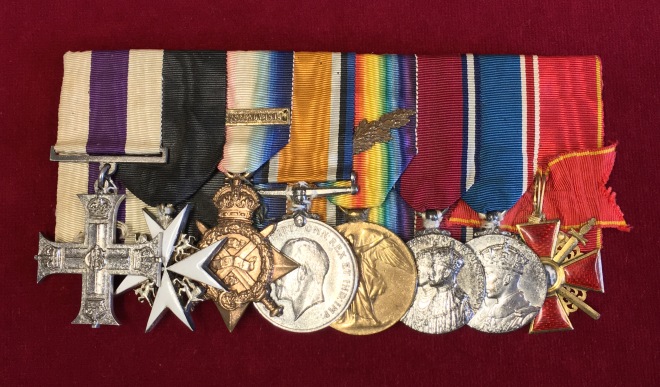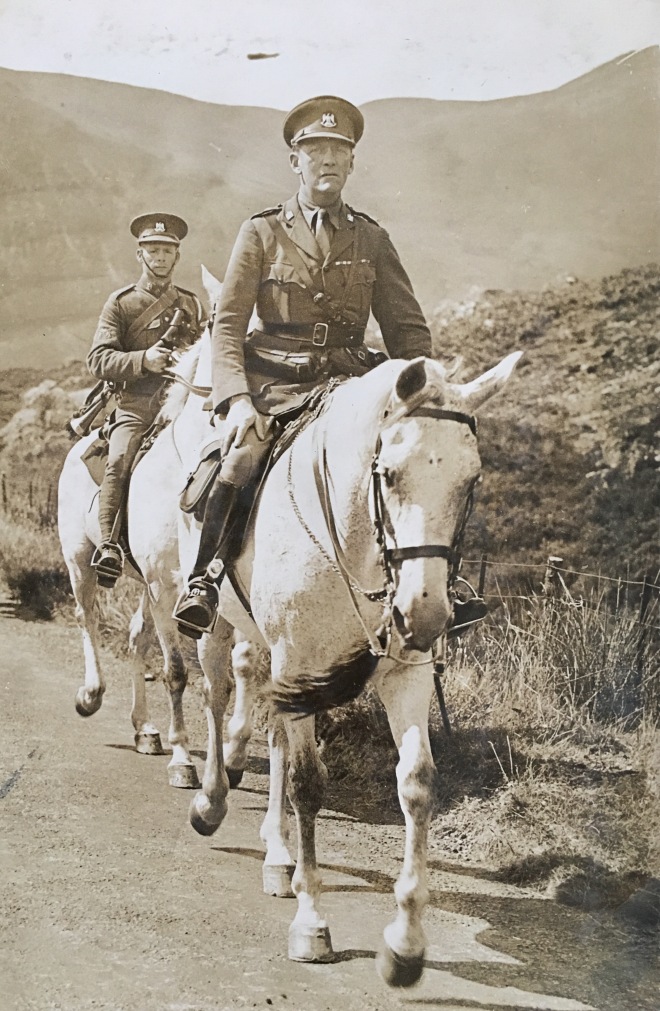The Orders, Decorations and Medals of Brigadier George Frederick Arthur Pigot-Moodie OstJ, MC (1888-1959), acquired in 2016 by The Royal Scots Dragoon Guards Museum with an NFA grant of £3,750.
In late 2016 the Royal Scots Dragoon Guards Museum acquired the collection of orders, decorations and medals of Brigadier George Frederick Arthur Pigot-Moodie, OstJ, MC, who served with the 2nd Dragoons (The Royal Scots Greys) from 1908 to 1938.
 Above: Brigadier Pigot-Moodie’s decorations ‘court-mounted’ on a bar-brooch. From left to right:
Above: Brigadier Pigot-Moodie’s decorations ‘court-mounted’ on a bar-brooch. From left to right:
- Military Cross 1915
- Badge of an Officer (Brother) of the Order of St John 1952
- 1914 Star (‘Mons Star’) with clasp ‘5th August-22nd November’
- British War Medal 1914-20
- Allied Victory Medal 1914-19 with Oak Leaf (signifying Mention in Dispatches)
- King George V Silver Jubilee Medal 1935
- King George VI Coronation Medal 1937
- Russian Order of St Anne, 2nd Class, with swords, 1915
George Pigot-Moodie was born in Cape Colony, South Africa, on 3 November 1888 to Scottish parents. The young George was sent to Britain to be educated at Harrow School followed by the Royal Military College, Sandhurst. George was commissioned into the 2nd Dragoons (The Royal Scots Greys) from RMC Sandhurst on 19 September 1908.
At the outbreak of the First World War Pigot-Moodie, by then a lieutenant, mobilised with the Greys and departed for France from York on 15 August 1914. He was the Regiment’s machine-gun officer, commanding twenty-nine other ranks armed with three Maxim machine-guns. The Greys were part of the 5th Cavalry Brigade of the British Expeditionary Force (BEF). The 5th Cavalry Brigade was deployed as part of the BEF’s withdrawal, subsequently known as the march ‘Mons to the Marne’ (23 August- 5 September 1914). On 22 August Lieutenant Pigot-Moodie demonstrated the effectiveness of well concealed machine-guns:
Pte. Dykes (Greys) met a patrol of 17 men. Hiding in a wood, the men were allowed to pass. Suddenly Lieut. Pigot-Moodie opened on them with his machine guns at a range of about a mile, and with the first burst hit every man.
For his services in the early engagements of the war Lieutenant Pigot-Moodie was among thirteen of all ranks of the Greys mentioned in dispatches by the commander of the BEF, Sir John French, on 8 October 1914.
On 1 January 1915 a new decoration for bravery was established, the Military Cross (MC), reserved for junior officers and warrant officers. Lieutenant Pigot-Moodie was the first officer of the 2nd Dragoons and the first from any of the antecedent regiments of The Royal Scots Dragoon Guards to receive the award; indeed, he was one of the first in the British Army to receive it.
 Above: Captain George Frederick Arthur Pigot-Moodie on the Western Front, 1915
Above: Captain George Frederick Arthur Pigot-Moodie on the Western Front, 1915
In 1915 Lieutenant Pigot-Moodie’s distinguished service, represented by his MC and mention in dispatches, was recognised by the Regiment’s Colonel-in-Chief, Tsar Nicholas II of Russia, by the award of the 2nd Class of the Order of St Anne, with swords. Pigot-Moodie was among a number of all ranks of the Greys to be awarded Russian decorations for gallantry and brave conduct on 24 September 1915.
On 16 October 1915 Pigot-Moodie was promoted substantive captain, on secondment from the Regiment. Almost a year later, on 3 September, he was promoted temporary major and, owing to his previous experience, was placed in command of a Machine-Gun School within the newly-formed Machine-Gun Corp. Within a month, on 11 November 1916, Pigot-Moodie was promoted temporary lieutenant-colonel in the Machine-Gun Corps (Infantry).
Pigot-Moodie received his second Mention in Dispatches on 13 November 1916 in a dispatch from the BEF’s commander, Sir Douglas Haig. From 1917 Pigot-Moodie served with the Egyptian Expeditionary Force (EEF) as part of XX Corps as a Corps Machine-Gun Officer. His third Mention in Despatches was in March 1919 from the commander of the EEF, Sir Edmund Allenby.
With the Armistice declared on 11 November 1918, Pigot-Moodie left the disbanding Machine-Gun Corps, relinquished his temporary rank of lieutenant-colonel and returned to the 2nd Dragoons, reverting to the rank of captain.
On 1 October 1932 Pigot-Moodie was promoted lieutenant-colonel to command The Royal Scots Greys, a post which he held for four years. In mid-1934, in order to raise the profile of the Regiment in its native Scotland and as an aid to recruiting, Pigot-Moodie led 21 officers and 250 men, 200 grey horses and the Regiment’s supporting motor transport on a 470-mile march through the country.
 Above: Lieutenant-Colonel Pigot-Moodie pictured with his personal trumpeter during the 470-mile ride of the Royal Scots Greys in Scotland, July – August, 1934
Above: Lieutenant-Colonel Pigot-Moodie pictured with his personal trumpeter during the 470-mile ride of the Royal Scots Greys in Scotland, July – August, 1934
Lieutenant-Colonel Pigot-Moodie relinquished command of the Regiment in Aldershot on 1 October 1936 and was promoted to the rank of colonel on the same day. Colonel Pigot-Moodie joined the list of officers on the Half Pay List pending further employment before moving to the Retired List in August 1938.
During the Second World War Colonel Pigot-Moodie appears to have been re-employed, possibly commanding a Pioneer Brigade in Eastern Command between 1944-45, though details of this are vague and await further research. He was finally retired and promoted to the honorary rank of Brigadier on 29 December 1945. In about 1952 it is thought Brigadier Pigot-Moodie returned to South Africa or Southern Rhodesia (now Zimbabwe). He died in South Africa on 14 June 1959.
Brigadier Pigot-Moodie’s orders, decorations and medals will be put on temporary display prior to forming part of a permanent display on the First World War in the planned large-scale refurbishment of the Royal Scots Dragoon Guards Museum galleries.
Paul Newman
Assistant Curator
The Royal Scots Dragoon Guards (Carabiniers and Greys) Regimental Museum
Stephen Wood MSA, FSA
Curatorial Adviser


